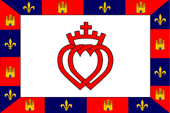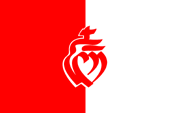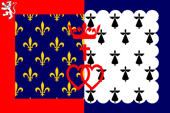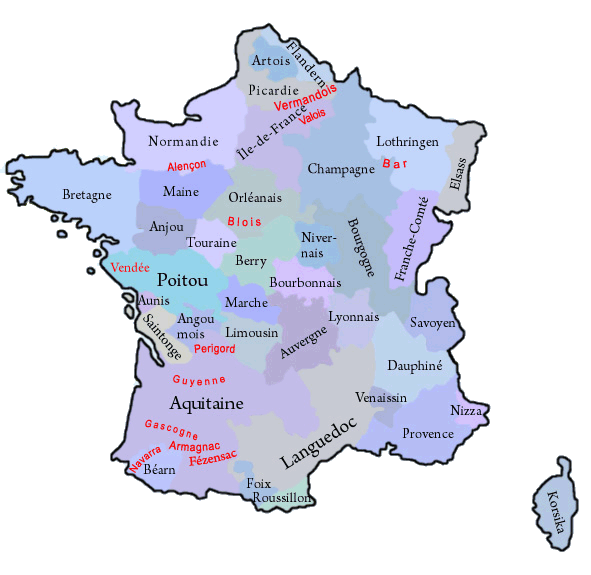mobile View, to the German Version tap the flag


- also: Lower Poitou
- Département of France
• Flag
• Meaning/Origin of the Flag
• Coat of Arms
• Meaning/Origin of the Coat of Arms
• Map of the historical Regions in France
• Explanations about the Regions
• Origin of the Country's Name

Flag of Vendée
– drapeau de Vendée,
Source, by: godenwindhelena.unblog.fr




Flag of Vendée
– drapeau de Vendée,
Source, by: Michel Disle




since 1960,
Unofficial flag of the Region of Pays-de-la-Loire
– Drapeau de officieux de la Region Pays-de-la-Loire,
Source, by: Wikipedia (D)






The flag of Vendée is a scutcheon-flag, it shows the image of the coat of arms the Département of Vendée. The designer Michel Disle has designed a flag for the Vendée, which is widely used. It shows two vertical stripes in red and white, and in the middle of the flag the "Sacré Coeur", a symbol what combines heart and cross, supplemented by a crown. The "Sacré-Coeur" was the symbol of the rebels, which arised from 1793 to 1800 against the French Revolution. The suppression of this uprising and the subsequent mass executions costed the life of approximately 200.000 residents of the Vendée. The in 1960 created Region of "Pays-de-la-Loire" uses officially an unhistorical flag, and this flag should not be a subject of any lexical considerations here. However, some sources in the internet show an historical flag for this region: In "Pays-de-la-Loire" is – probably and unofficially without doubt – a flag in use, modeled after historical coats of arms. It shows the heraldry of Maine, Anjou, Vendée and Bretagne.
Source:
Flags of the World,
Wikipedia (D),
Volker Preuß


Coat of arms of Vendée
– Blason du Vendée,
Source, by:
Wikipedia (D)

The coat of arms of Vendée shows a silvery shield, in it a red "Sacré-Coeur", surrounded by a 12 times between blue and red fragmented board, in it, alternating, a golden lily (on blue) and a golden castle (on red). The "Sacré-Coeur" was the symbol of the rebels, which arised from 1793 to 1800 against the French Revolution. The suppression of this uprising and the subsequent mass executions costed the life of approximately 200.000 residents of the Vendée.
Source:
Wikipedia (D),
Volker Preuß

The historical, French Regions:

in black: governorate and province in 1776,
in red: former county, province oder governorate
Map: Volker Preuß

The until the French Revolution existing provinces (or governorates) have been historically grown structures, which had their roots oftenly in former fiefdoms of the French crown, historic counties and duchies. They oftenly existed for hundreds of years and had preserved regionality (e.g. cultural particularities and regional languages). On the occasion of the French Revolution such phenomena were of course not desirable, and as part of their bloody and violent egalitarianism any regional references were eliminated. Shortly after the French Revolution the provinces were dissolved and France became divided into many départements, which should have approximately the same size and the same status. The départements were named after rivers or mountains, to use never and in no circumstances the name of an old province. However, there was no success in cutting the connections of the people of France to their respective regions, so that administrative regions were re-created in 1960, to have a better control in regional administrative processes. In this way became départements, which were placed in a historical province, administratively grouped to an oftenly historically named region. The resulted structures coincide only approximately with the boundaries of the old provinces. In the strictly centralist France any regionality is avoided, so that even the official flags of these regions mostly look like flags of companies, unloving, unhistorical, technocratic and modernistic, and these flags should not be a subject of any lexical considerations here. Only in a few of that regions, exist official flags which remember the historical models. But, even the existence of these today's regions is douptful, because in 2014 was passed a territorial reform valid from the year 2016, that reduces the number of the existing regions by merging to nearly the half. However, there exist unofficial flags in nearly all of these regions, which should remember the old provinces and the old heraldry.
Wikipedia Link to the regions of France:
click or tap here
FOTW Link to the regions of France:
click or tap here
Source: Flags of the World,
Wikipedia (D),
Volker Preuß

The area was (as a part of the province of Poitou) originally called Lower Poitou. After the French Revolution, the governorates (provinces) become abolished and divided into départements. The départements were named after rivers or mountains, to use never and in no circumstances the name of an old province. The today's Département of Vendée was named after a small river in the area.
Source:
Wikipedia (D),
Volker Preuß


![]()










